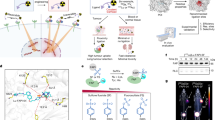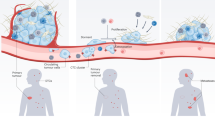Abstract
Stromal–epithelial interaction contributes to local prostate tumor growth, androgen-independent progression and distant metastasis. We have established in vitro coculture and in vivo chimeric tumor models to evaluate the roles of stromal cells isolated from either osteosarcoma or normal bone, a site where prostate cancer cells frequently metastasize, in contributing to the growth and survival of human prostate cancer cells. We have evaluated extensively the effects of toxic gene therapy using luciferase-tagged chimeric human prostate cancer models both in vitro and in vivo. In the in vitro cocultured cell model, we assessed cancer cell growth and residual cellular proteins after targeting either prostate cancer epithelial cells alone or both prostate cancer and bone stromal cells. In the in vivo animal model, we measured tumor volume and serum prostate-specific antigen (PSA) in mice bearing chimeric prostate tumors comprised of human prostate tumor cells and normal bone stromal cells. Our results demonstrated that: (1) The rate of human prostate cancer cell growth in vitro is accelerated by coculturing with human and rat osteosarcoma or normal mouse bone marrow stromal cell lines. No growth stimulation was noted when cocultured with a human prostate epithelial cell line. (2) Disabling the growth of normal bone stromal cells using transgenic targeting with a bystander gene, herpes simplex virus thymidine kinase (hsv-TK), plus the pro-drug ganciclovir (GCV) or acyclovir markedly depressed the growth of cocultured human prostate cancer cells in vitro and human prostate cancer–mouse normal bone stroma chimeric tumors in vivo. (3) By cotargeting both human prostate cancer and normal mouse bone stromal cells in vitro with an adenoviral construct, Ad-hOC-TK (a replication-defective Ad5 vector with the bystander transgene hsv-TK under the control of a human osteocalcin (hOC) promoter) plus GCV4, we observed greater inhibition of tumor cell growth than by targeting a single cell compartment with Ad-PSA-TK (a vector construct similar to Ad-hOC-TK except that the transgene expression is under regulation by a full-length human PSA promoter). These results, taken together, established a basic principle that cotargeting both tumor and its supporting stroma is more efficacious than targeting a single cell compartment in the treatment of human prostate cancer bone metastasis. This principle can be applied to other clinical conditions of cancer growth where stroma contribute to the overall growth and survival potential of the cancer.
This is a preview of subscription content, access via your institution
Access options
Subscribe to this journal
Receive 12 print issues and online access
$259.00 per year
only $21.58 per issue
Buy this article
- Purchase on Springer Link
- Instant access to full article PDF
Prices may be subject to local taxes which are calculated during checkout





Similar content being viewed by others
References
Sung SY, Chung LW . Prostate tumor–stroma interaction: molecular mechanisms and opportunities for therapeutic targeting. Differentiation. 2002;70:506–521.
Cunha GR, Hayward SW, Wang YZ . Role of stroma in carcinogenesis of the prostate. Differentiation. 2002;70:473–485.
Thalmann GN, Anezinis PE, Chang SM, et al. Androgen-independent cancer progression and bone metastasis in the LNCaP model of human prostate cancer. Cancer Res. 1994;54:2577–2581.
Tuxhorn JA, McAlhany SJ, Dang TD, Ayala GE, Rowley DR . Stromal cells promote angiogenesis and growth of human prostate tumors in a differential reactive stroma (DRS) xenograft model. Cancer Res. 2002;62:3298–3307.
Kurose K, Hoshaw-Woodard S, Adeyinka A, Lemeshow S, Watson PH, Eng C . Genetic model of multi-step breast carcinogenesis involving the epithelium and stroma: clues to tumour–microenvironment interactions. Hum Mol Genet. 2001;10:1907–1913.
Reubi JC, Horisberger U, Laissue J . High density of somatostatin receptors in veins surrounding human cancer tissue: role in tumor–host interaction? Int J Cancer. 1994;56:681–688.
Cleary KR, Batsakis JG . Undifferentiated carcinoma with lymphoid stroma of the major salivary glands. Ann Otol Rhinol Laryngol. 1990;99:236–238.
Wu HC, Hsieh JT, Gleave ME, Brown NM, Pathak S, Chung LW . Derivation of androgen-independent human LNCaP prostatic cancer cell sublines: role of bone stromal cells. Int J Cancer. 1994;57:406–412.
Chung LW, Chang SM, Bell C, Zhau HE, Ro JY, von Eschenbach AC . Co-inoculation of tumorigenic rat prostate mesenchymal cells with non-tumorigenic epithelial cells results in the development of carcinosarcoma in syngeneic and athymic animals. Int J Cancer. 1989;43:1179–1187.
Nemeth JA, Harb JF, Barroso Jr U, He Z, Grignon DJ, Cher ML . Severe combined immunodeficient-hu model of human prostate cancer metastasis to human bone. Cancer Res. 1999;59:1987–1993.
Chung LW, Gleave ME, Hsieh JT, Hong SJ, Zhau HE . Reciprocal mesenchymal–epithelial interaction affecting prostate tumour growth and hormonal responsiveness. Cancer Surv. 1991;11:91–121.
Tuxhorn JA, Ayala GE, Rowley DR . Reactive stroma in prostate cancer progression. J Urol. 2001;166:2472–2483.
Chung LW, Li W, Gleave ME, et al. Human prostate cancer model: roles of growth factors and extracellular matrices. J Cell Biochem Suppl. 1992;16H:99–105.
Hsieh CL, Chung LW . New prospectives of prostate cancer gene therapy: molecular targets and animal models. Crit Rev Eukaryot Gene Expression. 2001;11:77–120.
Yeung F, Chung LW . Molecular basis of co-targeting prostate tumor and stroma. J Cell Biochem Suppl. 2002;38:65–72.
Farnsworth WE . Prostate stroma: physiology. Prostate. 1999;38:60–72.
Chung LW . The role of stromal–epithelial interaction in normal and malignant growth. Cancer Surv. 1995;23:33–42.
Nemeth JA, Roberts JW, Mullins CM, Cher ML . Persistence of human vascular endothelium in experimental human prostate cancer bone tumors. Clin Exp Metastasis. 2000;18:231–237.
Matsubara S, Wada Y, Gardner TA, et al. A conditional replication-competent adenoviral vector, Ad-OC-E1a, to cotarget prostate cancer and bone stroma in an experimental model of androgen-independent prostate cancer bone metastasis. Cancer Res. 2001;61:6012–6019.
Tu SM, Millikan RE, Mengistu B, et al. Bone-targeted therapy for advanced androgen-independent carcinoma of the prostate: a randomised phase II trial. Lancet. 2001;357:336–341.
Diduch DR, Coe MR, Joyner C, Owen ME, Balian G . Two cell lines from bone marrow that differ in terms of collagen synthesis, osteogenic characteristics, and matrix mineralization. J Bone Joint Surg Am. 1993;75:92–105.
Graham FL, Prevec L . Methods for construction of adenovirus vectors. Mol Biotechnol. 1995;3:207–220.
Bosch RJ, Woolf AS, Fine LG . Gene transfer into the mammalian kidney: direct retrovirus-transduction of regenerating tubular epithelial cells. Exp Nephrol. 1993;1:49–54.
Yeung F, Li X, Ellett J, Trapman J, Kao C, Chung LW . Regions of prostate-specific antigen (PSA) promoter confer androgen-independent expression of PSA in prostate cancer cells. J Biol Chem. 2000;275:40846–40855.
Wu TT, Sikes RA, Cui Q, et al. Establishing human prostate cancer cell xenografts in bone: induction of osteoblastic reaction by prostate-specific antigen-producing tumors in athymic and SCID/bg mice using LNCaP and lineage-derived metastatic sublines. Int J Cancer. 1998;77:887–894.
Hsieh CL, Yang L, Miao L, et al. A novel targeting modality to enhance adenoviral replication by vitamin D(3) in androgen-independent human prostate cancer cells and tumors. Cancer Res. 2002;62:3084–3092.
Ishii-Morita H, Agbaria R, Mullen CA, et al. Mechanism of ‘bystander effect’ killing in the herpes simplex thymidine kinase gene therapy model of cancer treatment. Gene Ther. 1997;4:244–251.
Wu Y, Yakar S, Zhao L, Hennighausen L, LeRoith D . Circulating insulin-like growth factor-I levels regulate colon cancer growth and metastasis. Cancer Res. 2002;62:1030–1035.
Shariat SF, Lamb DJ, Kattan MW, et al. Association of preoperative plasma levels of insulin-like growth factor I and insulin-like growth factor binding proteins-2 and -3 with prostate cancer invasion, progression, and metastasis. J Clin Oncol. 2002;20:833–841.
Jackson MW, Roberts JS, Heckford SE, et al. A potential autocrine role for vascular endothelial growth factor in prostate cancer. Cancer Res. 2002;62:854–859.
Soker S, Kaefer M, Johnson M, Klagsbrun M, Atala A, Freeman MR . Vascular endothelial growth factor-mediated autocrine stimulation of prostate tumor cells coincides with progression to a malignant phenotype. Am J Pathol. 2001;159:651–659.
Ferrer FA, Miller LJ, Lindquist R, et al. Expression of vascular endothelial growth factor receptors in human prostate cancer. Urology. 1999;54:567–572.
Kassen AE, Sensibar JA, Sintich SM, Pruden SJ, Kozlowski JM, Lee C . Autocrine effect of DHT on FGF signaling and cell proliferation in LNCaP cells: role of heparin/heparan-degrading enzymes. Prostate. 2000;44:124–132.
Ropiquet F, Berthon P, Villette JM, Le Brun G, Maitland NJ, Cussenot O, et al. Constitutive expression of FGF2/bFGF in non-tumorigenic human prostatic epithelial cells results in the acquisition of a partial neoplastic phenotype. Int J Cancer. 1997;72:543–547.
Sitaras NM, Sariban E, Bravo M, Pantazis P, Antoniades HN . Constitutive production of platelet-derived growth factor-like proteins by human prostate carcinoma cell lines. Cancer Res. 1988;48:1930–1935.
Pirtskhalaishvili G, Nelson JB . Endothelium-derived factors as paracrine mediators of prostate cancer progression. Prostate. 2000;44:77–87.
Dong Z, Nemeth JA, Cher ML, Palmer KC, Bright RC, Fridman R . Differential regulation of matrix metalloproteinase-9, tissue inhibitor of metalloproteinase-1 (TIMP-1) and TIMP-2 expression in co-cultures of prostate cancer and stromal cells. Int J Cancer. 2001;93:507–515.
Nemeth JA, Yousif R, Herzog M, et al. Matrix metalloproteinase activity, bone matrix turnover, and tumor cell proliferation in prostate cancer bone metastasis. J Natl Cancer Inst. 2002;94:17–25.
Koeneman KS, Yeung F, Chung LW . Osteomimetic properties of prostate cancer cells: a hypothesis supporting the predilection of prostate cancer metastasis and growth in the bone environment. Prostate. 1999;39:246–261.
Lin DL, Tarnowski CP, Zhang J, et al. Bone metastatic LNCaP-derivative C4-2B prostate cancer cell line mineralizes in vitro. Prostate. 2001;47:212–221.
Pollard M . Lobund–Wistar rat model of prostate cancer in man. Prostate. 1998;37:1–4.
Noble RL . The development of prostatic adenocarcinoma in Nb rats following prolonged sex hormone administration. Cancer Res. 1977;37:1929–1933.
Lubaroff DM, Canfield L, Rasmussen GT, Reynolds CW . An animal model for the study of prostate carcinoma. Natl Cancer Inst Monogr. 1978: 275–281.
Greenberg NM, DeMayo F, Finegold MJ, et al. Prostate cancer in a transgenic mouse. Proc Natl Acad Sci USA. 1995;92:3439–3443.
Maroulakou IG, Anver M, Garrett L, Green JE . Prostate and mammary adenocarcinoma in transgenic mice carrying a rat C3(1) simian virus 40 large tumor antigen fusion gene. Proc Natl Acad Sci USA. 1994;91:11236–11240.
Moolten FL . Tumor chemosensitivity conferred by inserted herpes thymidine kinase genes: paradigm for a prospective cancer control strategy. Cancer Res. 1986;46:5276–5281.
Freeman SM, Abboud CN, Whartenby KA, et al. The “bystander effect”: tumor regression when a fraction of the tumor mass is genetically modified. Cancer Res. 1993;53:5274–5283.
Kitazono M, Goldsmith ME, Aikou T, Bates S, Fojo T . Enhanced adenovirus transgene expression in malignant cells treated with the histone deacetylase inhibitor FR901228. Cancer Res. 2001;61:6328–6330.
Okegawa T, Pong RC, Li Y, Bergelson JM, Sagalowsky AI, Hsieh JT . The mechanism of the growth-inhibitory effect of coxsackie and adenovirus receptor (CAR) on human bladder cancer: a functional analysis of car protein structure. Cancer Res. 2001;61:6592–6600.
Acknowledgements
We are grateful to Mr Gary Mawyer for editorial assistance and Drs Chinghai Kao and Song-Chu Ko for advice and discussion.
Author information
Authors and Affiliations
Corresponding author
Additional information
This work was supported in part by NASA NCC8-171, NIH CA85555 and CA098912, DoD DAMO 17-03-2-0033 and a CaPCURE Foundation award to LWKC.
Rights and permissions
About this article
Cite this article
Hsieh, CL., Gardner, T., Miao, L. et al. Cotargeting tumor and stroma in a novel chimeric tumor model involving the growth of both human prostate cancer and bone stromal cells. Cancer Gene Ther 11, 148–155 (2004). https://doi.org/10.1038/sj.cgt.7700665
Received:
Published:
Issue Date:
DOI: https://doi.org/10.1038/sj.cgt.7700665
Keywords
This article is cited by
-
Bone-stromal cells up-regulate tumourigenic markers in a tumour-stromal 3D model of prostate cancer
Molecular Cancer (2013)
-
Enhanced combined tumor-specific oncolysis and suicide gene therapy for prostate cancer using M6 promoter
Cancer Gene Therapy (2009)
-
Keystone symposium: The role of microenvironment in tumor induction and progression, Banff, Canada, 5–10 February 2005
Breast Cancer Research (2005)
-
Cotargeting tumor and tumor endothelium effectively inhibits the growth of human prostate cancer in adenovirus-mediated antiangiogenesis and oncolysis combination therapy
Cancer Gene Therapy (2005)



